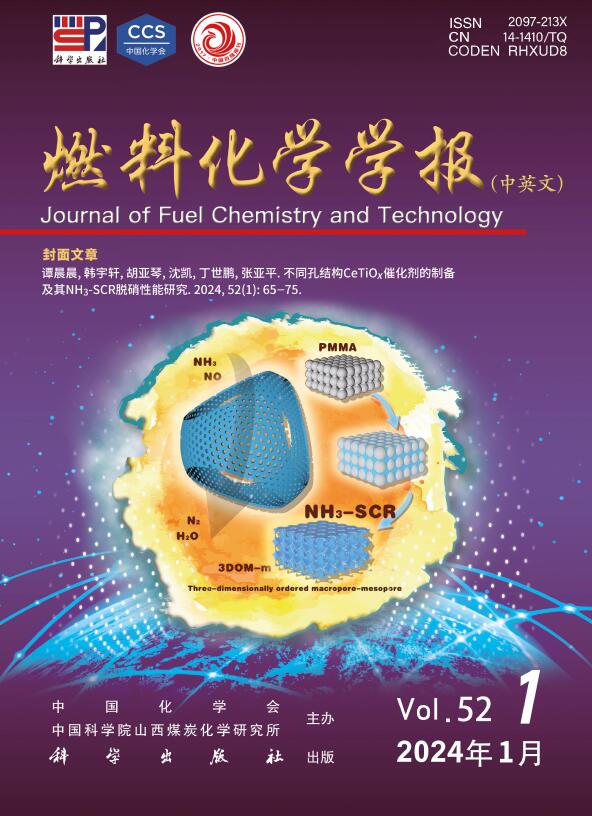Evolution of hydrogen cyanide generated from polyacrylonitrile pyrolysis based on TG-LAS
Q3 Energy
引用次数: 0
Abstract
An on-line detection system for detecting hydrogen cyanide (HCN) of polyacrylonitrile (PAN) pyrolysis based on thermogravimetric-tunable diode laser absorption spectroscopy (TG-TDLAS) is constructed. Taking advantage of the characteristics that HCN has a relatively high absorption intensity at a wavelength of 1531.156 nm and that common gases in the background gas in this wavelength band cause less interference, concentration of HCN is obtained by demodulating the second harmonic of the absorption signal. By a high-precision flow controller and dilution proportioning with 99.99% standard nitrogen gas, five standard gases in the range of 20×10–6–100×10–6 mol/mol are obtained. The demodulated second harmonic signal is linearly fitted with a correlation coefficient of 0.9975. Effects of four different relative molecular mass of PANs and three heating rates on the pyrolysis were analyzed. The relationship between sample weight loss rate and amount of HCN released was studied to explore non-isothermal pyrolysis kinetics of PAN. A three-stage pyrolysis kinetic model is established by dividing pyrolysis temperature stages, and the activation energies and frequency factors of different relative molecular mass at different heating rates are calculated, respectively. The results show that the higher the molecular weight and the higher the viscosity, the smaller the HCN release. HCN release and PAN weight loss rate in the first and third stages are larger than that in the second stage. It provides a certain experimental basis for further study of HCN generation mechanism in PAN pyrolysis.
基于TG-LAS的聚丙烯腈热解生成氰化氢的演化
建立了基于热重可调二极管激光吸收光谱(TG-TDLAS)的聚丙烯腈(PAN)热解氰化氢(HCN)在线检测系统。利用HCN在1531.156 nm波长处具有较高的吸收强度以及该波段背景气体中常见气体干扰较小的特点,通过解调吸收信号的二次谐波得到HCN的浓度。通过高精度流量控制器和99.99%标准氮气的稀释配比,得到了20×10-6-100×10-6 mol/mol范围内的5种标准气体。解调后的二次谐波信号线性拟合,相关系数为0.9975。分析了四种不同相对分子质量和三种加热速率对pan热解的影响。研究了样品失重速率与HCN释放量的关系,探讨了PAN的非等温热解动力学。通过划分热解温度阶段,建立了三阶段热解动力学模型,分别计算了不同加热速率下不同相对分子质量的活化能和频率因子。结果表明,分子量越大、黏度越高,HCN释放量越小。第一期和第三期HCN释放量和PAN失重率均大于第二期。为进一步研究PAN热解过程中HCN生成机理提供了一定的实验依据。
本文章由计算机程序翻译,如有差异,请以英文原文为准。
求助全文
约1分钟内获得全文
求助全文
来源期刊

燃料化学学报
Chemical Engineering-Chemical Engineering (all)
CiteScore
2.80
自引率
0.00%
发文量
5825
期刊介绍:
Journal of Fuel Chemistry and Technology (Ranliao Huaxue Xuebao) is a Chinese Academy of Sciences(CAS) journal started in 1956, sponsored by the Chinese Chemical Society and the Institute of Coal Chemistry, Chinese Academy of Sciences(CAS). The journal is published bimonthly by Science Press in China and widely distributed in about 20 countries. Journal of Fuel Chemistry and Technology publishes reports of both basic and applied research in the chemistry and chemical engineering of many energy sources, including that involved in the nature, processing and utilization of coal, petroleum, oil shale, natural gas, biomass and synfuels, as well as related subjects of increasing interest such as C1 chemistry, pollutions control and new catalytic materials. Types of publications include original research articles, short communications, research notes and reviews. Both domestic and international contributors are welcome. Manuscripts written in Chinese or English will be accepted. Additional English titles, abstracts and key words should be included in Chinese manuscripts. All manuscripts are subject to critical review by the editorial committee, which is composed of about 10 foreign and 50 Chinese experts in fuel science. Journal of Fuel Chemistry and Technology has been a source of primary research work in fuel chemistry as a Chinese core scientific periodical.
 求助内容:
求助内容: 应助结果提醒方式:
应助结果提醒方式:


